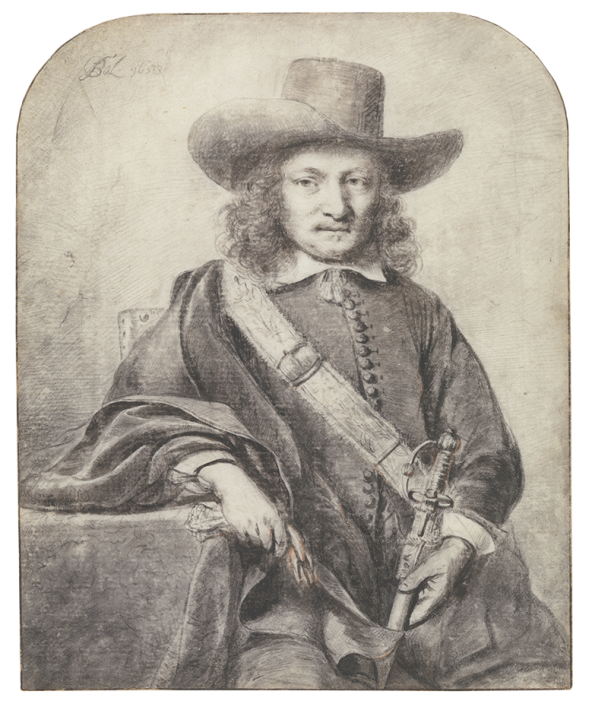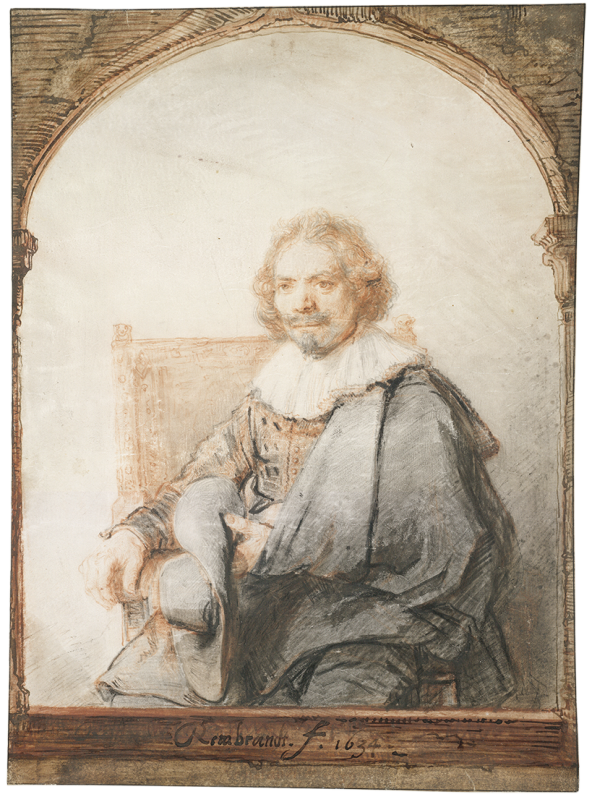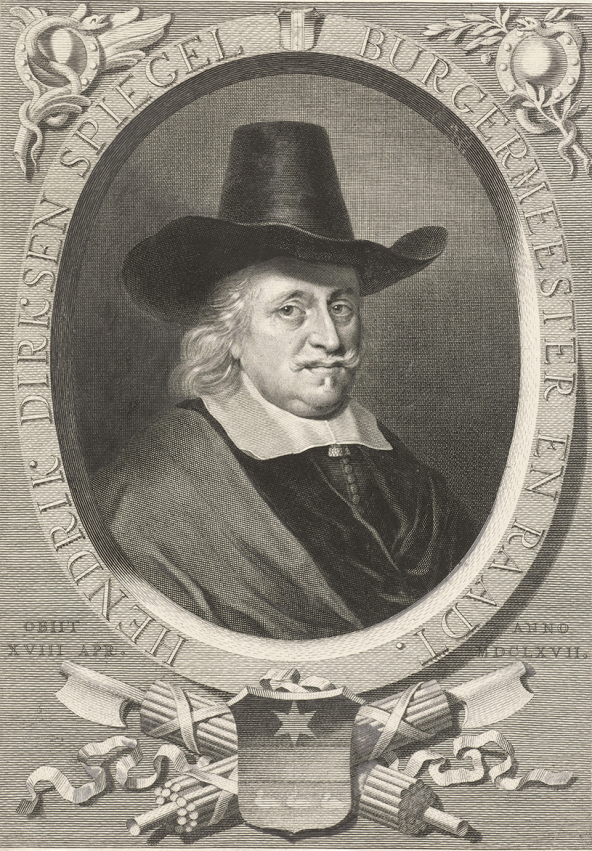Choose a background colour
Ferdinand Bol, Dutch, 1616-1680: Portrait of a Gentleman (Elbert or Hendrick Dircksz Spiegel?), 1642
Black chalk, with black, gray, and brown washes on vellum.
6 × 5 3⁄8 in. (15.2 × 13.7 cm)
Recto, left, signed and dated, in black ink, Bol: f 1643; verso, lower left corner, in pen, N2333 (Goll van Franckenstein inv. no.); just above that, in graphite, 36. F. Bol.
- Chain Lines:
- None.
- Watermark:
- None.
- Provenance:
Johann Goll van Franckenstein, 1722 – 1785, Amsterdam (Lugt 2987); by descent, Johan Goll van Franckenstein, 1750 – 1821, Amsterdam; by descent, Pieter Hendrick Goll van Franckenstein, 1787 – 1832, Amsterdam; his sale, Amsterdam, De Vries, Roos and others, 1 July 1833, Kunstboek I, no. 8: Een deftig gekleed Man met een ronde hoed op zijn hoofd. Als voren (op perkament) met zw. krijt en o.i. inkt door Ferdinand Bol (Nlg. 26 to Brondgeest); Jan Gijsbert Verstolk van Soelen, 1776 – 1845, The Hague and Soelen; his sale, Amsterdam, De Vries, Brondgeest & Roos, 22 March 1847, lot 49 (to Brondgeest); dealer, H. Bouvier & Co., Bonn, 1947; Charles Augustus, Grand Duke of Saxe-Weimar-Eisenach, 1912 – 1988; dealer, Arnoldi-Livie, Munich; sale, Amsterdam, Christie’s, 9 November 1998, lot 128; Sheldon and Leena Peck, Boston (Lugt 3847); gift to the Ackland Art Museum, inv. no. 2017.1.8.
- Literature/Exhibitions:
Bouvier & Co. 1947, no. 6; Sumowski 1965, 124; Sumowski Drawings, vol. 1, 212 – 13, no. 94; P. Schatborn in Amsterdam 2017 – 18, 203.
- Ackland Catalogue:
- 2017.1.8
Although finished portrait drawings by Rembrandt and his circle are rare, they typically represented family members and close friends. This sitter has been identified as one of the brothers Elbert or Hendirck Dircksz Spiegel, uncles to Ferdinand Bol’s wife and important patrons of the artist. The artist likely kept this drawing for many years, as the brothers’ names are recorded in a list of five portrait drawings in an inventory of Bol’s studio made twenty-six years later. Whichever brother is featured here, the sitter conveys a dignified presence and stands before a classical column, a traditional reference to stability and fortitude.
This is one of only two signed and dated portrait drawings by Ferdinand Bol. The other, dated ten years later (1653), bears the traditional title of Portrait of a Gouda Officer Fig. 18.1.1

Ferdinand Bol, Portrait of a Gouda Officer, 1653. Black chalk with gray washes on vellum, 178 × 146 mm. Amsterdam, Amsterdam Museum, Fodor Collection, inv. no. ta 10133.
Amsterdam Museum, C. J. Fodor Collection
Bol made it relatively early in his career, shortly after he had established himself as an independent master in Amsterdam, and after completing his highly formative period studying with and working for Rembrandt. Despite the fact that only a few finished portrait drawings by Bol’s hand survive, he devoted a great portion of his early career to portrait painting, depicting many of Amsterdam’s elite in Rembrandt’s then much-in-demand style.2
Although the Peck drawing was listed by Werner Sumowski in his 1979 catalogue of the artist’s drawings, it has received little attention to date. Even Sumowski had difficulty in ascertaining basic data, such as the drawing’s measurements, and in reading the correct year on this longmissing work.3
A finished portrait drawing on vellum like this was probably intended as a freestanding work, durable enough to be framed and wallmounted. Neither this drawing nor the Portrait of a Gouda Officer, also on vellum, relate to any known painting. Such finished portrait drawings by Rembrandt and his circle are rare, but they often depicted family members or more intimate acquaintances despite the fact (or due to it) that such drawn portraits did not constitute a regular part of their artistic practice. Bol’s contemporary and fellow Rembrandt pupil, Gerbrand van den Eeckhout (1621 – 1674), for example, made a similar black chalk and wash drawing on vellum of his father in 1644.4
Rembrandt himself, in a striking black and red chalk drawing from 1634, portrayed a man who has been identified as his relative, Willem van der Pluym Fig. 18.2.5

Rembrandt, Portrait of Willem van der Pluym, 1634. Red and black chalk with brown wash on vellum, 373 × 272 mm. New York, private collection.
Private Collection
Rembrandt’s drawing and the present sheet share the distinctive tight wrapping of the sitter’s arm in a cloak draped from one shoulder, apparently the only time he made use of this particular pose. Bol (and possibly Rembrandt) may have borrowed the motif from Anthony van Dyck (1599 – 1641), who used it several times in his highly influential series of portrait prints, the Iconography.6
This toga-like affectation certainly lends a humanistic air to the sitter, as does the classical column behind him, the latter serving as a fairly standard motif denoting stability or fortitude that had already long been popular in European portraiture.7
Given the close association of this type of drawing to family members in the oeuvres of Rembrandt and his circle, it would be worth considering Bol’s family along these lines as well. An inventory of Bol’s possessions drawn up in 1669 reveals five portrait drawings listed among the paintings.8
The entries read:
60. een teekeningh naer mijn schoonvader
one drawing of my father-in-law
61. een do. naer mijn vader
one ditto of my father
62. een do. naer burgemr. Spiegel
one ditto of Burgomaster Spiegel9
63. een do. naer den ontfanger Spiegel
one ditto of the Receiver Spiegel
64. een do. naer de keurvorst Brandenburch
one ditto of the Elector of Brandenburg
The first two are self-explanatory in terms of family relationship, while the last, the Elector of Brandenburg, was clearly not a family member (though he was a great Calvinist military hero). The Peck drawing, in all probability, is one of the two in the inventory that represents the Spiegels (nos. 62, 63), who were brothers and also relatives of Bol’s first wife, Elisabeth Dell (1628 – 1660). Their relationship to Elisabeth has sometimes been incorrectly cited in the past, but each was in fact an uncle of hers.10
Elbert Dircksz Spiegel (1600 – 1674) became the receiver general of the Amsterdam Admiralty in 1641, after studying law at Leiden University, where he received his doctorate in 1625.11
Hendrick Dircksz Spiegel (1598 – 1667) built a career as a regent, serving first on the Amsterdam city council, and then becoming highly prominent when he served as burgomaster (mayor) of Amsterdam four times between 1655 and 1665.12
These brothers, their sister Geertruyt Spiegel (1601 – 1661), and their respective descendants were among Bol’s most important patrons throughout his career. The true extent of the Spiegel family members’ patronage has only recently been better understood, but appears to account for a significant number of Bol’s portrait commissions in total, including some of his most innovative works.13
In their early to mid-forties in 1643, Elbert and Hendrick were the only male members of their family who would have been about the age of the sitter in the Peck drawing. Bol made multiple paintings of Elbert in later years, such as the one in Winterthur that shows him around the age of sixty Fig. 18.3.14

Ferdinand Bol, Portrait of Elbert Spiegel, 1660. Oil on canvas, 110 × 92 cm. Winterthur, Kunst Museum, inv. no. g.2018.50.
Kunst Museum Winterthur, Geschenk der Stiftung Jakob Briner, 2018. Photograph Prudence Cuming Associates Limited, London
Despite being older, his likeness reveals perceptible resemblances to the drawing in terms of his deep-set eyes, prominent nose, and facial hair. As for Hendrick, no painting by Bol is known, but his likeness can be found in an engraving based on a now lost painting by Michiel van Limborch from 1663 Fig. 18.4.15

Jan van Munnickhuysen, after Michiel van Limborch, Portrait of Hendrick Dircksz. Spiegel, Burgomaster of Amsterdam, 1685 (after a painting from 1663). Engraving on paper, 268 × 189 mm. Amsterdam, Rijksmuseum, inv. no. rp-p-ob-23.773.
Rijksmuseum, Amsterdam
He is certainly heavier and older than the figure in the drawing from twenty years earlier, but his facial characteristics, and what might even be construed as his personality, seem to fit even more convincingly than those of Elbert.
As Erna Kok has detailed, the Spiegel brothers’ importance for Bol’s career extended beyond just executing family portraits.16
Bol carried out several high-profile commissions for both the Admiralty, in which Elbert was highly placed, and for the city of Amsterdam, in which Hendrick was highly placed. Documents suggest deep personal ties as well. Hendrick bore witness to the baptism of Bol’s son in 1660, and Elbert was a declared guardian of Bol’s children in 1669.17
While Bol’s marriage into this family in 1653 seems to have had major career consequences, it is also entirely possible that his relationship to the Spiegel family predated that union, since this drawing was made a full ten years before his marriage. If indeed depicting one of the Spiegel brothers, it is interesting that Bol held onto the drawing (along with other images of his former in-laws) years after his wife’s death in 1660, as his 1669 inventory attests.
End Notes
Sumowski Drawings, vol. 1, 240 – 41, no. 108; Broos 1981, 101 – 03, no. 26; and P. Schatborn in Amsterdam 2017 – 18, 203. 2 For Bol’s early career as a portraitist, see Blankert 1982, 56 – 57; and R. Ekkart in Amsterdam 2017 – 18, 148 – 50.
For Bol’s early career as a portraitist, see Blankert 1982, 56 – 57; and R. Ekkart in Amsterdam 2017 – 18, 148 – 50.
Sumowski Drawings, vol. 1, 212 – 13, no. 94.
Kupferstich-Kabinett, Dresden, inv. no. C 1455; and Dresden & Vienna 1997 – 98, 204 – 05, no. 96.
Schatborn & Hinterding 2019, 411, no. D630; and Amsterdam 2019, 61 – 65. Willem van der Pluym was the uncle in Amsterdam of Rembrandt’s Leiden cousin Karel van der Pluym (1625 – 1672). Karel was a painter who almost certainly studied with Rembrandt (perhaps while living with Willem) and in any case remained close to him throughout their lives, as later documents suggest. The identification of this sitter as Willem van der Pluym is not entirely secure, but seems likely.
See, for example, various entries in Antwerp & Amsterdam 1999 – 2000, such as nos. 7, 9, and 18.
For Bol’s use of the column motif and its range of associations, see De Jongh 1981 – 82, 155 – 58.
For a transcription, somewhat imprecise, see Blankert 1982, 76 – 78, dated 8 October 1669; originally and more reliably published in Bredius 1910, 233 – 35. The inventory was drawn up as part of Bol’s marriage contract with his second wife, Anna van Arckel. These drawings are briefly discussed by P. Schatborn in Amsterdam 2017 – 18, though with some errors: no mother-in-law is mentioned, and Elbert Spiegel was not Bol’s brother-in-law but rather his uncle by marriage (discussed further below).
Mistakenly transcribed as mr. instead of burgemr. in Blankert 1982, 77; but the distinction is important (see below) since it indeed identifies him correctly as burgomaster. The transcription error is repeated in Amsterdam 2017 – 18, 203, taking it from Blankert.
For the Spiegel family tree, see Grijzenhout & Kok 2017, 128 – 29.
Ekkart 2002, 20 – 22.
Ekkart 2002, 20, 25, 30. Blankert mistakenly thought that Hendrick was Elisabeth Dell’s grandfather rather than uncle: see Blankert 1982, 20; corrected in Ekkart 2002, 25 (note 33).
For the Spiegel family’s patronage of Bol, see Kok 2016; E. Kok in Amsterdam 2017 – 18, 58 – 79; and Grijzenhout & Kok 2017.
Blankert 1982, 149, no. 159; Ekkart 2002, 35, no. S14; and Amsterdam 2017 – 18, 77, fig. 98. For other documented likenesses of Elbert Spiegel, see Ekkart 2002, 34, no S12 (not traced); idem, 39, no. T11 (Art Museum, Kharkov); and idem, 39, no. T12 (not traced).
Hollstein, vol. 14, no. 29. The only other known likeness of Hendrick Spiegel is that found in the group portrait of the Crossbowman’s Civic Guard in the Amsterdam Museum, inv. no. A 7330. See Gent 2012, 259 – 60; and Meijer & Van der Molen 2014, 7. Gent identifies Hendrick Spiegel as the fourth gentleman from the left holding a sheet of paper.
For Bol’s patronage network and its importance, see Blankert 1975; Kok 2016; and idem in Amsterdam 2017 – 18, 58 – 79.
Blankert 1982, 74; documents dated 24 March 1660 and 27 September 1669.
